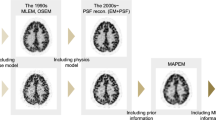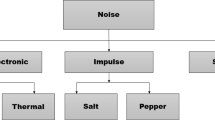Abstract
Purpose
A major challenge for the material decomposition task of the dual-energy computed tomography (DECT) is the algorithm often suffers from heavy noise in the results. The purpose of this study is to propose a scheme to increase the noise performance of material decomposition.
Methods
The scheme we propose in this paper is to apply an autoencoder-based denoising procedure to the photon-counting DECT images before they are fed into the material decomposition algorithm. We implement the autoencoder (AE) by stacking a series of convolutional and deconvolutional layers. The decomposition technique adopted in our work is an iterative method using least squares estimation with the Huber loss function. The noises of the input and the output of material decomposition are analyzed with both simulated data and real data. Phantom and chicken wing experiments are conducted with a photon-counting-based spectral CT scanner to evaluate the proposed material decomposition scheme.
Results
The noise analysis of the input and the output of material decomposition demonstrates a positive correlation between them. Comparative experiment indicates a noise reduction in the output density maps for 26.07% to 35.65% after the autoencoder pre-processing is applied. The resultant contrast-to-noise ratio is largely increased, correspondingly.
Conclusions
By utilizing the additional autoencoder denoising step, the material decomposition algorithm achieves an improvement in the noise performance of the resultant density maps.











Similar content being viewed by others
References
R.E. Alvarez, A. Macovski, Energy-selective reconstruction in X-ray computerized tomography. Phys. Med. Biol. 21, 733–744 (1976)
L.A. Lehmann, R.E. Alvarez, A. Macovski, W.R. Brody, N.J. Pelc, S.J. Riederer, A.L. Hall, Generalized image combinations in dual KVP digital radiography. Med. Phys. 8, 659–667 (1981)
W.A. Kalender, W.H. Perman, J.R. Vetter, E. Klotz, Evaluation of a prototype dual-energy computed tomographic apparatus. Med. Phys. 13, 334–339 (1986)
S.C. Kappadath, C.C. Shaw, Dual-energy digital mammography: calibration and inverse-mapping techniques to estimate calcification thickness and glandular-tissue ratio. Med. Phys. 30, 1110–1117 (2006)
R. Alvarez, Estimator for photon counting energy selective X-ray imaging with multibin pulse height analysis. Med. Phys. 38, 2324–2334 (2011)
S. Lee, Y.-N. Choi, H.-J. Kim, Quantitative material decomposition using spectral computed tomography with an energy-resolved photon-counting detector. Phys. Med. Biol. 59, 5457–5482 (2014)
Y. Long, J.A. Fessler, Multi-material decomposition using statistical image reconstruction for spectral CT. IEEE Trans. Med. Imaging 33, 1614–1626 (2014)
M. Firsching, J. Giersch, D. Niederlöhner, G. Anton, A method for stoichiometric material reconstruction with spectroscopic X-ray pixel detectors, in IEEE Nuclear Science Symposium Conference Record, vol. 7 (2004), pp. 4116–4119
J. Giersch, M. Firsching, D. Niederlöhner, G. Anton, Material reconstruction with spectroscopic pixel X-ray detectors. Nucl. Instrum. Methods Phys. Res. A 546, 125–130 (2005)
M. Firsching, P.T. Talla, T. Michel, G. Anton, Material resolving X-ray imaging using spectrum reconstruction with Medipix2. Nucl. Instrum. Methods Phys. Res. A 591, 19–23 (2008)
P.V. Granton, S.I. Pollmann, N.L. Ford, M. Drangova, D.W. Holdsworth, Implementation of dual- and triple-energy cone-beam micro-CT for postreconstruction material decomposition. Med. Phys. 35, 5030–5042 (2008)
M. Firsching, A.P. Butler, N. Scott, N.G. Anderson, T. Michel, G. Anton, Contrast agent recognition in small animal CT using the Medipix2 detector. Nucl. Instrum. Methods Phys. Res. A 607, 179–182 (2009)
H. Ding, M. Klopfer, J. Ducote, F. Masaki, S. Molloi, Breast tissue characterization with photon-counting spectral CT imaging: a postmortem breast study. Radiology 272, 731–738 (2014)
X. Dong, T. Niu, L. Zhu, Combined iterative reconstruction and image-domain decomposition for dual energy CT using total-variation regularization. Med. Phys. 41, 051909 (2014)
R.F. Barber, E.Y. Sidky, T.G. Schmidt, X. Pan, An algorithm for constrained one-step inversion of spectral CT data. Phys. Med. Biol. 61, 3784–3818 (2016)
B. Chen, Z. Zhang, E.Y. Sidky, X. Pan, Image reconstruction and scan configurations enabled by optimization-based algorithms in multispectral CT. Phys. Med. Biol. 62, 8763–8793 (2017)
S. Niu, G. Yu, J. Ma, J. Wang, Nonlocal low-rank and sparse matrix decomposition for spectral CT reconstruction. Inverse Probl. 34, 024003 (2018)
S. Chang, X. Mou, A statistical iterative reconstruction framework for dual energy computed tomography without knowing tube spectrum, in Developments in X-ray Tomography X (2016)
K.-S. Chuang, H.K. Huang, Comparison of four dual energy image decomposition methods. Phys. Med. Biol. 33, 455–466 (1988)
Q. Xu, X. Mou, S. Tang, W. Hong, Y. Zhang, T. Luo, Implementation of penalized-likelihood statistical reconstruction for polychromatic dual-energy CT, in Medical Imaging 2009: Physics of Medical Imaging, vol. 72585 (2009), pp. 72585I-1–72585I-9
H.Q. Le, S. Molloi, Least squares parameter estimation methods for material decomposition with energy discriminating detectors. Med. Phys. 38, 245–255 (2011)
H. Ding, J.L. Ducote, S. Molloi, Breast composition measurement with a cadmium-zinc-telluride based spectral computed tomography system. Med. Phys. 39, 1289–1297 (2012)
J. Lin, H. Zhang, J. Huang, Z. Bian, S. Zhang, Y. Wang, Y. Liao, S. Li, H. Zhang, D. Zeng, J. Ma, Iterative reconstruction for low does dual energy CT using information-divergence constrained spectral redundancy information. J. X-ray Sci. Technol. 26, 311–330 (2018)
J. Harms, T. Wang, M. Petrongolo, T. Niu, L. Zhu, Noise suppression for dual-energy CT via penalized weighted least-square optimization with similarity-based regularization. Med. Phys. 43, 2676–2686 (2016)
Y. Xue, R. Ruan, H. Xinhua, Yu. Kuang, J. Wang, Y. Long, T. Niu, Statistical image-domain multimaterial decomposition for dual-energy CT. Med. Phys. 44, 886–901 (2017)
Q. Ding, T. Niu, X. Zhang, Y. Long, Image-domain multimaterial decomposition for dual-energy CT based on prior information of material images. Med. Phys. 45, 3614–3626 (2018)
U. Tanyeri, R. Demirci, Wavelet-based adaptive anisotropic diffusion filter. Adv. Electr. Comput. Eng. 18, 99–106 (2018)
B. Ye, X. Wu, Wavelet denoising arithmetic research based on small hepatocellular carcinoma CT image, in 3rd International Conference on Bioinformatics and Biomedical Engineering (2009)
Z. Cao, X. Zhang, PDE-based non-linear anisotropic diffusion techniques for medical image denoising, in 2012 Spring Congress on Engineering and Technology (2012), pp. 1–4
Q. Liu, S. Wang, J. Luo, Y. Zhu, M. Ye, An augmented Lagrangian approach to general dictionary learning for image denoising. J. Vis. Commun. Image Represent. 23, 753–766 (2012)
S. Wang, Q. Liu, Y. Xia, P. Dong, J. Luo, Q. Huang, D.D. Feng, Dictionary learning based impulse noise removal via L1–L1 minimization. Signal Process. 93, 2696–2708 (2013)
Q. Chen, W. Dapeng, Image denoising by bounded block matching and 3D filtering. Signal Process. 90, 2778–2783 (2010)
X.-J. Mao, C. Shen, Y.-B. Yang, Image restoration using very deep convolutional encoder-decoder networks with symmetric skip connections, in 29th Conference on Neural Information Processing Systems (2016)
H. Chen, Y. Zhang, M.K. Kalra, F. Lin, Y. Chen, P. Liao, J. Zhou, G. Wang, Low-dose CT with a residual encoder-decoder convolutional neural network. IEEE Trans. Med. Imaging 36, 2524–2535 (2017)
T. Niu, X. Dong, M. Petrongolo, L. Zhu, Iterative image-domain decomposition for dual-energy CT. Med. Phys. 41, 041901-1–041901-10 (2014)
S. Tang, M. Yang, X. Hu, T. Niu, Multiscale penalized weighted least-squares image-domain decomposition for dual-energy CT, in 2015 IEEE Nuclear Science Symposium and Medical Imaging Conference (NSS/MIC) (2015), pp. 1–6
C.-Y. Liou, W.-C. Cheng, J.-W. Liou, D.-R. Liou, Autoencoder for words. Neurocomputing 139, 84–96 (2014)
D. Kumar, A. Wong, D.A. Clausi, Lung nodule classification using deep features in CT images, in 2015 IEEE 12th Conference on Computer and Robot Vision (2015), pp. 133–138
J.-Z. Cheng, D. Ni, Y.-H. Chou, J. Qin, C.-M. Tiu, Y.-C. Chang, C.-S. Huang, D. Shen, C.-M. Chen, Computer-aided diagnosis with deep learning architecture: applications to breast lesions in US images and pulmonary nodules in CT scans. Sci. Rep. 6, 24454 (2016)
M. Kallenberg, K. Petersen, M. Nelsen, A.Y. Ng, P. Diao, C. Igel, C.M. Vachon, K. Holland, R.R. Winkel, N. Karssemeijer, M. Lillholm, Unsupervised deep learning applied to breast density segmentation and mammographic risk scoring. IEEE Trans. Med. Imaging 35, 1322–1331 (2016)
R. Hata, M.A.H. Akhand, K. Murase, Multi-valued autoencoders and classification of large-scale multi-class problem. Int. J. Adv. Comput. Sci. Appl. 8, 19–26 (2017)
Y. Pu, Z. Gan, R. Henao, X. Yuan, C. Li, A. Stevens, L. Carin, Variational autoencoder for deep learning of images, labels and captions, in 30th Conference on Neural Information Processing Systems (NIPS 2016)
M. Nishio, C. Nagashima, S. Hirabayashi, A. Ohnishi, K. Sasaki, T. Sagawa, M. Hamada, T. Yamashita, Convolutional auto-encoder for image denoising of ultra-low-dose CT. Heliyon 3, e00393 (2017)
H. Chen, Y. Zhang, W. Zhang, P. Liao, K. Li, J. Zhou, G. Wang, Low-dose CT denosing with convolutional neural network, in 2017 IEEE 14th International Symposium on Biomedical Imaging (2017), pp. 143–146
C. You, Q. Yang, H. Shan, L. Gjesteby, G. Li, J. Shenghong, Z. Zhang, Z. Zhao, Y. Zhang, W. Cong, G. Wang, Structurally-sensitive multi-scale deep neural network for low-dose CT denosing. IEEE Access. 6, 41839–41855 (2018)
M. Zeiler, ADADELTA: an adaptive learning rate method (2012). arXiv:1212.5701v1
B. Li, B. Li, J. Luo, P. Tang, J. Mao, W. Xiaoye, Simultaneous reduction in noise and cross-contamination artifacts for dual-energy X-ray CT. Biomed. Res. Int. 2013, 1–8 (2013)
W. Dufan, L. Zhang, X. Zhu, X. Xiaofei, S. Wang, A weighted polynomial based material decomposition method for spectral x-ray CT imaging. Phys. Med. Biol. 61, 3749–3783 (2016)
Acknowledgements
This work is supported by the National Key R&D Program of China (Grant No. 2016YFC0100400), the Instrument Developing Project of the Chinese Academy of Sciences (Grant No. YZ201511) and the Key Technology Research and Development Team Project of Chinese Academy of Sciences (Grant No. GJJSTD2017005).
Author information
Authors and Affiliations
Corresponding author
Rights and permissions
About this article
Cite this article
Li, M., Wang, Z., Xu, Q. et al. A study on noise reduction for dual-energy CT material decomposition with autoencoder. Radiat Detect Technol Methods 3, 44 (2019). https://doi.org/10.1007/s41605-019-0122-2
Received:
Revised:
Accepted:
Published:
DOI: https://doi.org/10.1007/s41605-019-0122-2




